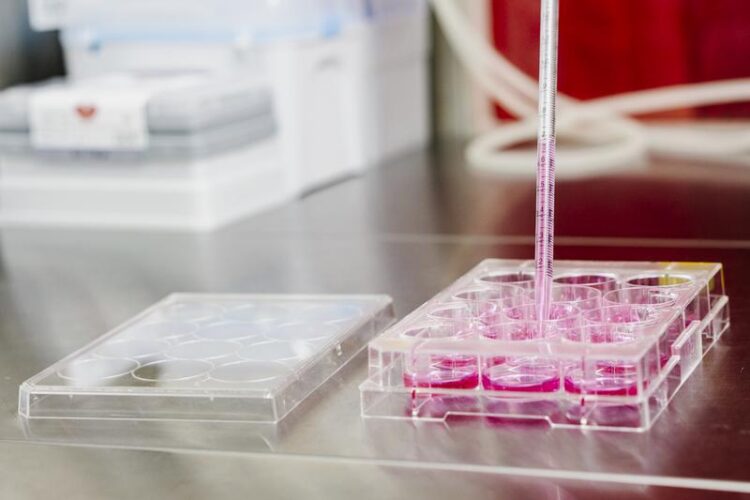New standards to quantify hepatitis B virus reservoirs in liver cells

HBV research in cell cultures.
(c) UKE/T Volz
Approximately 300 million people are chronically infected with the hepatitis B virus (HBV), which can cause liver cirrhosis or cancer.
Consequently, there is an urgent need for the development of HBV curative therapies. Due to the unique replication strategy of HBV, however, quantification of viral DNA in infected liver cells, which is essential in preclinical and clinical studies, is technically difficult and not standardised. An international research consortium led by DZIF scientists has now developed recommendations for the optimisation, control and validation of quantitative viral DNA measurements, which could be crucial for preclinical and clinical evaluation of therapeutic strategies.
HBV is a DNA virus that specifically infects human hepatocytes. After infection, the DNA genome of the virus is converted by cellular enzymes into covalently closed circular DNA (cccDNA), which forms stable mini chromosomes within the cell nuclei by association with cellular chromosomal proteins. In this form, the viral DNA then serves as a template for the formation of new virus particles. A major limitation of preclinical and clinical HBV research is the lack of standardised PCR-based methods for the specific quantification of viral DNA present as cccDNA in HBV-infected samples. As part of an international consortium supported by the International Coalition to Eliminate HBV (ICE-HBV), DZIF scientists at the University Medical Center Hamburg-Eppendorf, Heidelberg University and the Technical University of Munich worked together with the French L’Agence nationale de recherches sur le sida et les hépatites virales (ANRS) and colleagues at Gilead Sciences in the USA to compare protocols and develop evidence-based best practices guidance to quantify cccDNA by quantitative PCR.
“When comparing different protocols for quantifying HBV DNA in tissue samples, we found that the coexistence of different forms of viral DNA as well as conditions of sample preservation and treatment strongly affect PCR-based quantification of HBV cccDNA,” says DZIF young investigator Dr Lena Allweiss, who led the collaboration of the six participating laboratories. Based on the study results, the team developed sample type-tailored methodological recommendations for the optimisation, control and validation of the quantitative measurement of HBV cccDNA.
“The study will assist the HBV cure research programmes aiming at assessing the impact of therapies on the cellular HBV reservoir in preclinical studies and clinical trials,” sums up study lead Prof. Maura Dandri, DZIF scientist at the University Medical Center Hamburg-Eppendorf, the results of the study.
Wissenschaftliche Ansprechpartner:
Prof. Maura Dandri
University Medical Center Hamburg-Eppendorf
E-MAIL: m.dandri[at]uke.de
Prof. Stephan Urban
Heidelberg University
E-MAIL: stephan.urban[at]med.uni-heidelberg.de
Prof. Ulrike Protzer
Technical University of Munich
E-MAIL: protzer[at]tum.de
Originalpublikation:
Quantification of the hepatitis B virus cccDNA: Evidence-based guidelines for monitoring the key obstacle of HBV cure, Lena Allweiss et al., Gut, 2023, DOI:10.1136/gutjnl-2022-328380
Weitere Informationen:
https://www.dzif.de/en/new-standards-quantify-hepatitis-b-virus-reservoirs-liver… DZIF press release
Media Contact
All latest news from the category: Life Sciences and Chemistry
Articles and reports from the Life Sciences and chemistry area deal with applied and basic research into modern biology, chemistry and human medicine.
Valuable information can be found on a range of life sciences fields including bacteriology, biochemistry, bionics, bioinformatics, biophysics, biotechnology, genetics, geobotany, human biology, marine biology, microbiology, molecular biology, cellular biology, zoology, bioinorganic chemistry, microchemistry and environmental chemistry.
Newest articles

Innovative 3D printed scaffolds offer new hope for bone healing
Researchers at the Institute for Bioengineering of Catalonia have developed novel 3D printed PLA-CaP scaffolds that promote blood vessel formation, ensuring better healing and regeneration of bone tissue. Bone is…

The surprising role of gut infection in Alzheimer’s disease
ASU- and Banner Alzheimer’s Institute-led study implicates link between a common virus and the disease, which travels from the gut to the brain and may be a target for antiviral…

Molecular gardening: New enzymes discovered for protein modification pruning
How deubiquitinases USP53 and USP54 cleave long polyubiquitin chains and how the former is linked to liver disease in children. Deubiquitinases (DUBs) are enzymes used by cells to trim protein…



